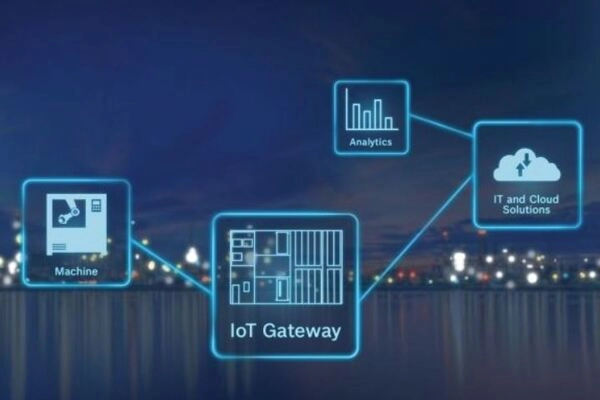In the era of the Internet of Things (IoT), connecting and managing billions of smart devices has become a major challenge for businesses, factories, cities, and even smart agriculture. For IoT devices to communicate, transmit data, and operate efficiently, a crucial component is the IoT Gateway, also known as Gateway IoT. This article provides a detailed analysis of IoT Gateways, including how they work, their benefits, functions, real-world applications, and future potential.
What is an IoT Gateway?
An IoT Gateway is an intermediary device that connects IoT devices with each other and with cloud computing systems. It is not just a simple data bridge but also performs essential functions such as data processing, security, and management of smart devices.

Gateway IoT is a critical component in the IoT ecosystem, especially as the number of devices and the volume of data continue to grow. The gateway ensures that data from sensors, cameras, or industrial equipment is collected, pre-processed, and securely transmitted to a central management system or the cloud.
This not only optimizes operational efficiency but also minimizes security risks and data loss, thereby providing stability for the entire IoT system.
How does a Gateway IoT work?
A Gateway IoT operates as an intermediary: it connects devices, collects data, performs preliminary processing, and transmits the information to cloud systems or management servers.

IoT Gateways support a variety of protocols such as MQTT, CoAP, HTTP, and Modbus, enabling the integration of diverse devices ranging from temperature and humidity sensors, surveillance cameras, to industrial equipment. Gateways can perform data encryption, device authentication, and even filter unnecessary information before transmitting it to the cloud.
In this way, the gateway not only ensures that data is transmitted accurately and securely but also reduces the load on cloud systems, optimizes bandwidth, and speeds up response times for real-time applications.
Understanding how a Gateway IoT operates helps businesses and developers build efficient IoT systems while reducing operational and maintenance costs.
Benefits of using an IoT Gateway
Using an IoT Gateway provides numerous practical benefits for IoT systems. Gateways not only connect devices but also enhance operational efficiency, improve data security, and save energy.
Faster Data Processing and Reduced Latency
One of the standout advantages of a Gateway IoT is its ability to process data locally (edge computing) before sending it to the cloud. This reduces latency and enhances response times for real-time applications, such as smart traffic systems, security monitoring, or industrial equipment control.
Additionally, local data processing reduces the load on central servers, saves bandwidth and storage costs, and increases system reliability during network disruptions.
Enhanced Security for IoT Systems
Security is always a top concern in IoT. An IoT Gateway plays a key role in controlling data flow, encrypting information, and authenticating devices before transmitting data to the cloud.
This helps prevent risks from hackers, malware, or unauthorized access, while protecting sensitive data—particularly in industries such as manufacturing, healthcare, energy, and transportation.
Energy Savings and Optimized Device Performance
By processing and filtering data directly at the gateway, a Gateway IoT reduces unnecessary data transmissions, thereby saving energy for IoT devices.
Furthermore, the gateway monitors device performance, sends alerts when issues are detected, and optimizes device operations according to actual needs. This ensures the IoT system operates reliably, stably, and cost-effectively.
Key Functions of a Gateway IoT
A Gateway IoT does more than just connect devices—it performs multiple essential functions that make an IoT system smarter and more flexible.

Connecting and Transmitting Data Between Devices and the Cloud
The most basic function of an IoT Gateway is to connect devices and transmit data to cloud systems. This allows data from sensors, cameras, machinery, and smart devices to be centralized, analyzed, and utilized for various purposes, ranging from monitoring and reporting to remote control.
Gateways support multiple protocols and connection standards, enabling IoT systems to integrate flexibly with devices from different manufacturers.
Filtering, Analyzing, and Local Data Storage
Beyond data transmission, a Gateway IoT can also process data locally: filtering unnecessary information, performing preliminary analysis, and storing data on-site.
This reduces the load on cloud systems, saves bandwidth and storage costs, and ensures that critical data is always available for real-time analysis or decision-making.
Managing and Controlling IoT Devices
Another key function of a Gateway IoT is device management and control. Gateways support software updates, configuration settings, monitoring device status, and adjusting operations as needed.
This enables businesses and organizations to centrally manage their entire IoT system, minimize operational risks, and maximize device utilization efficiency.
Real-World Applications of IoT Gateways
IoT Gateways are widely used across various sectors, including transportation, agriculture, energy management, and smart factories.
In Smart Transportation
In smart transportation systems, IoT Gateways connect sensors, surveillance cameras, traffic lights, and data collection devices. Gateways process real-time data, optimize traffic coordination, reduce congestion, and enhance public safety.

Thanks to local data processing capabilities, emergency situations such as accidents or traffic congestion can be responded to quickly without relying entirely on a central server.
In Smart Agriculture
In smart agriculture, a Gateway IoT connects sensors that monitor soil moisture, temperature, pH levels, automatic irrigation systems, and crop or livestock monitoring devices. The gateway enables data collection, analysis, and automated decision-making, helping to increase productivity, save water and energy, and reduce operational costs.

For example, if soil moisture falls below the designated level, the Gateway IoT will automatically activate the irrigation system and simultaneously send an alert to the manager.
In Energy Management and Smart Factories
In factories and energy management systems, IoT Gateways monitor machinery operations, collect energy consumption data, detect faults, and optimize overall performance.

In factories and energy management systems, IoT Gateways monitor machinery operations, collect energy consumption data, detect faults, and optimize performance.
Gateways help reduce energy waste, extend device lifespan, improve operational safety, and support data-driven decision-making. In smart buildings, IoT Gateways also contribute to more efficient management of lighting, air conditioning, and other electrical devices.
Advantages and Future Potential of IoT Gateways
IoT Gateways offer numerous advantages: fast data processing, reduced latency, enhanced security, energy savings, and effective device management.
In the future, as IoT continues to grow, Gateway IoT will become an even more powerful data processing hub, integrating AI for analytics and predictive insights, supporting connectivity with 5G networks and new protocols. Gateways will also evolve to provide higher levels of automation and upgraded security, expanding their applications across industries, smart cities, agriculture, and energy management.
This creates significant potential for businesses and IoT system developers, helping reduce costs, increase operational efficiency, and enhance user experience.
IoT Gateways are an indispensable component of the IoT ecosystem. From connecting devices, transmitting data, securing systems, to managing and controlling devices, gateways enable IoT systems to operate intelligently, efficiently, and safely. With strong future growth potential, IoT Gateways will continue to be a key solution driving the global IoT era, from smart cities and smart agriculture to factories and energy management.
